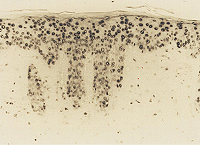anti-8-Hydroxy-2'-deoxyguanosine [8-OHdG], mAb (N45.1)
| Code | Size | Price |
|---|
| JAI-MOG-020P-20ug | 20 ug | £251.00 |
Quantity:
Prices exclude any Taxes / VAT
Overview
Antibody Isotype: Mouse IgG1kappa
Antibody Clonality: Monoclonal
Antibody Clone: N45.1
Regulatory Status: RUO
Target Species: Human
Applications:
- Enzyme-Linked Immunosorbent Assay (ELISA)
- Immunohistochemistry (IHC)
Shipping:
BLUE ICE
Storage:
-20°C
Images
Documents
Further Information
EClass:
32160000
Form (Short):
liquid
Formulation:
Lyophilized. Contains 10mM PBS, pH7.4 containing 1.0% BSA.
Handling Advice:
Avoid freeze/thaw cycles.
Immunogen:
8-Hydroxy-2?-deoxyguanosine (8OHdG) conjugated keyhole limpet hemocyanin.
Long Description:
Monoclonal Antibody. Recognizes 8-OHdG. Does not cross-react with 19 analogues of 8-OHdG (guanosine (G), 7-methylG, 6-SHG, 8-bromoG, dA, dC, dT, dI, dU, dG, O6-methyldG, 8-OHdA, guanine (Gua), O6-methylGua, 8-OHGua, uric acid, urea, creatine, creatinine). Minimal cross-reactivity with 8-sulfhydrylG and 8-OHG (less than 1%). Lyophilized. Contains 10mM PBS, pH7.4 containing 1.0% BSA. 8-hydroxy-2'-deoxyguanosine (8-OHdG) is a modified base that occurs in DNA due to attack by hydroxyl radicals (incl. singlet oxygen and direct photodynamic action) that are formed as byproducts and intermediates of aerobic metabolism and during oxidative stress. There is increasing evidence to support the involvement of free radical reactions in the damage of biomolecules that eventually lead to several diseases in humans, such as atherosclerosis, cerebral and heart ischemia-reperfusion injury, cancer, rheumatoid arthritis, inflammation, diabetes, aging, and neurodegenerative conditions, such as Alzheimer's disease. 8-OHdG is popular as a sensitive, stable and integral marker of oxidative damage in cellular DNA and can be detected in tissue, serum, urine and other biomaterials.
Package Type:
Plastic Vial
Product Description:
8-hydroxy-2'-deoxyguanosine (8-OHdG) is a modified base that occurs in DNA due to attack by hydroxyl radicals (incl. singlet oxygen and direct photodynamic action) that are formed as byproducts and intermediates of aerobic metabolism and during oxidative stress. There is increasing evidence to support the involvement of free radical reactions in the damage of biomolecules that eventually lead to several diseases in humans, such as atherosclerosis, cerebral and heart ischemia-reperfusion injury, cancer, rheumatoid arthritis, inflammation, diabetes, aging, and neurodegenerative conditions, such as Alzheimer?s disease. 8-OHdG is popular as a sensitive, stable and integral marker of oxidative damage in cellular DNA and can be detected in tissue, serum, urine and other biomaterials.
Source / Host:
Ascites
Specificity:
Recognizes 8-OHdG. Does not cross-react with 19 analogues of 8-OHdG (guanosine (G), 7-methylG, 6-SHG, 8-bromoG, dA, dC, dT, dI, dU, dG, O6-methyldG, 8-OHdA, guanine (Gua), O6-methylGua, 8-OHGua, uric acid, urea, creatine, creatinine). Minimal cross-reactivity with 8-sulfhydrylG and 8-OHG (less than 1%).
Transportation:
Non-hazardous
UNSPSC Category:
Primary Antibodies
UNSPSC Number:
12352203
Use & Stability:
Stable for at least 3 years after receipt when stored at -20°C. After reconstitution, prepare aliquots and store at -20°C.
References
Quantitative immunohistochemical determination of 8-hydroxy-2'deoxyguanosine by a monoclonal antibody N45.1: Its application to ferric nitrilotriacetate-induced renal carcinogenesis model: S. Toyokuni, et al.; Lab. Invest. 76, 365 (1997) [Specifity of the antibody clone N45.1] | 8-Hydroxy-2'deoxyguanosine is increased in epidermal cells of hairless mice after chronic ultraviolet B exposure: Y. Hattori, et al.; J. Invest. Dermatol. 107, 733 (1996) [Immunohistochemistry of UV-B irradiated mouse skin] | Induction and nuclear translocation of thioredoxin by oxidative damage in the mouse kidney: independence of tubular necrosis and sulfhydryl depletion: T. Tanaka, et al.; Lab. Invest. 77, 145 (1997) [Immunohistochemistry of ferric nitrotriacetate-treated mouse kidney] | Hyperglycemia causes oxidative stress in pancreatic -cells of GK rats, a model of type 2 diabetes: Y. Ihara, et al.; Diabetes 48, 927 (1999) [Immunohistochemistry of pancreatic islets from GK rat, a diabetes model] | DNA oxidation injury in bone early after steroid administration is involved in the pathogenesis of steroid-induced osteonecrosis: T. Ichiseki, et al.; Rheumatology 44, 456 (2005) [Immunohistochemistry of rabbit tissue] | Protective effect of persimmon (Diospyros kaki) peel proanthocyanidin against oxidative damage under H2O2 -induced cellular senescence: Y.A. Lee, et al.; Biol. Pharm. Bull. 31, 1265 (2008) [Application to human cultured cells] | Click here for more literature references! http://www.jaica.com/e/technical_forum_8ohdg.html#8OHdG_AB_REF
Related Products
| Product Name | Product Code | Supplier | 8-OHdG Check ELISA Kit | JAI-KOG-200SE | JaICA | Summary Details | |||||||||||||||||||||||||||||||||||||||||||||||||||||||||||||||||||||||||||||||||||||||||||||
|---|---|---|---|---|---|---|---|---|---|---|---|---|---|---|---|---|---|---|---|---|---|---|---|---|---|---|---|---|---|---|---|---|---|---|---|---|---|---|---|---|---|---|---|---|---|---|---|---|---|---|---|---|---|---|---|---|---|---|---|---|---|---|---|---|---|---|---|---|---|---|---|---|---|---|---|---|---|---|---|---|---|---|---|---|---|---|---|---|---|---|---|---|---|---|---|---|---|---|---|
| 8-OHdG Check ELISA Kit (High Sensitivity) | JAI-KOG-HS10E | JaICA | Summary Details | ||||||||||||||||||||||||||||||||||||||||||||||||||||||||||||||||||||||||||||||||||||||||||||||||
| anti-8-Hydroxy-2'-deoxyguanosine [8-OHdG], mAb (N45.1) | JAI-MOG-100P | JaICA | Summary Details | ||||||||||||||||||||||||||||||||||||||||||||||||||||||||||||||||||||||||||||||||||||||||||||||||



